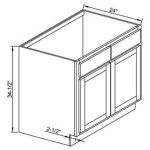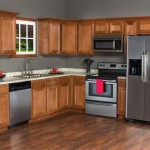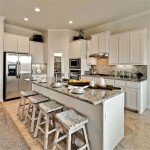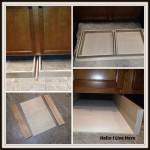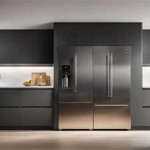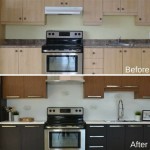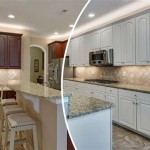Kitchen Cabinet Drawer and Door Handles: A Comprehensive Guide
Kitchen cabinet drawer and door handles, often underestimated, are critical components in both the functionality and aesthetics of a kitchen. They serve as the physical interface for accessing storage and contribute significantly to the overall style and ambiance of the space. Selecting the right handles requires careful consideration of several factors, including material, style, size, and ergonomics. Compromising on these elements can lead to an unsatisfying kitchen experience, both in terms of usability and visual appeal.
This article provides a comprehensive overview of kitchen cabinet drawer and door handles, covering various aspects from materials and styles to installation and maintenance. The intent is to furnish homeowners, designers, and contractors with the knowledge needed to make informed decisions when choosing these essential kitchen hardware elements.
Material Selection: Balancing Durability and Style
The material of kitchen cabinet handles directly impacts their durability, appearance, and cost. Several options are available, each with its own set of advantages and disadvantages. Making an informed choice requires understanding these properties.
Stainless Steel: Stainless steel is a popular choice due to its durability, resistance to corrosion, and sleek, modern appearance. It is also relatively easy to clean and maintain, making it a practical option for a high-traffic kitchen environment. Stainless steel handles are available in brushed, polished, and matte finishes, offering versatility in design integration. However, stainless steel can be susceptible to fingerprint smudges, which may require frequent cleaning to maintain a pristine look. Furthermore, higher grades of stainless steel can be more expensive than other materials.
Brass: Brass handles offer a classic and elegant aesthetic. They are known for their warm tones and ability to develop a patina over time, adding character and a vintage feel. Brass is a durable material, but it can tarnish if not properly maintained. Regular polishing is often required to preserve its original luster. Brass handles are available in various finishes, including polished brass, antique brass, and satin brass, allowing for customization to suit different kitchen styles. The cost of brass handles can vary depending on the quality and intricacy of the design.
Bronze: Bronze handles are similar to brass in terms of durability and aesthetic appeal, but they typically have a darker, richer color. They are often chosen for kitchens with a rustic or traditional design. Bronze is also resistant to corrosion and can develop a beautiful patina over time. Like brass, bronze handles may require occasional polishing to maintain their desired appearance. They are available in various finishes, including oil-rubbed bronze and antique bronze. The cost of bronze handles can be comparable to or slightly higher than that of brass handles.
Zinc Alloy: Zinc alloy is a cost-effective alternative to stainless steel, brass, and bronze. It offers good durability and can be molded into a variety of shapes and designs. Zinc alloy handles are often coated with a finish such as chrome, nickel, or black to enhance their appearance and protect them from corrosion. While zinc alloy is generally durable, it may not be as resistant to wear and tear as stainless steel or solid brass. It is, however, a popular choice for budget-conscious homeowners who still desire a stylish and functional kitchen.
Ceramic and Glass: Ceramic and glass handles add a touch of elegance and sophistication to kitchen cabinets. They are available in a wide range of colors, patterns, and designs, allowing for unique customization. Ceramic and glass handles are typically more delicate than metal handles and require careful handling to avoid chipping or breaking. They are often used in kitchens with a vintage or cottage-style design. The cost of ceramic and glass handles can vary depending on the materials used and the complexity of the design.
Wood: Wooden handles offer a natural and warm aesthetic. They are often used in kitchens with a rustic or farmhouse-style design. Wooden handles can be made from various types of wood, such as maple, oak, or walnut. They may be stained or painted to match the cabinet finish. Wooden handles require regular maintenance to protect them from moisture and prevent warping or cracking. They are generally less durable than metal handles and may not be suitable for high-traffic areas. However, they provide a comfortable grip and a distinctive visual appeal.
Style Considerations: Matching Handles to Kitchen Aesthetics
The style of kitchen cabinet handles should complement the overall design of the kitchen. Choosing handles that clash with the cabinet style or other design elements can detract from the overall aesthetic. There are several popular handle styles to choose from, each suited to different kitchen designs.
Knobs: Knobs are small, round or shaped handles that are attached to the cabinet door or drawer with a single screw. They are a versatile option that can be used in a variety of kitchen styles, from traditional to modern. Knobs are often less expensive than pulls and are easy to install. However, they may not provide as much leverage as pulls, which can make them less convenient for opening heavy drawers or doors. Knobs are available in a wide range of materials, finishes, and designs.
Pulls: Pulls are elongated handles that are attached to the cabinet door or drawer with two or more screws. They provide more leverage than knobs, making them easier to grip and open heavy doors or drawers. Pulls are available in various shapes and sizes, including bar pulls, arch pulls, and cup pulls. Bar pulls are a popular choice for modern kitchens, while arch pulls and cup pulls are often used in traditional or transitional kitchens. Pulls are available in a wide range of materials, finishes, and designs.
Bar Pulls: Bar pulls are a sleek and modern type of pull that consists of a straight bar attached to the cabinet door or drawer with two or more screws. They are often made from stainless steel or other metals and have a minimalist design. Bar pulls are a popular choice for contemporary kitchens and can be used on both cabinets and drawers. They provide a comfortable grip and a clean, uncluttered look.
Cup Pulls: Cup pulls are a traditional type of pull that is shaped like an inverted cup. They are often made from brass or bronze and have a vintage or antique appearance. Cup pulls are commonly used on drawers in traditional or farmhouse-style kitchens. They provide a comfortable grip and add a touch of elegance to the kitchen design.
Appliance Pulls: Appliance pulls are larger and more robust than standard cabinet pulls. They are designed to be used on appliances such as refrigerators, dishwashers, and ovens. Appliance pulls are typically made from stainless steel or other durable materials and are available in various sizes and styles to match the kitchen design. They provide a secure grip and make it easier to open heavy appliance doors.
Edge Pulls: Edge pulls are mounted on the edge of the cabinet door or drawer, creating a minimalist and seamless look. They are often used in modern or contemporary kitchens where a clean and uncluttered aesthetic is desired. Edge pulls are available in various materials and finishes and can be easily installed. They provide a discreet and functional way to open cabinets and drawers.
Size and Ergonomics: Prioritizing Comfort and Accessibility
The size and ergonomics of kitchen cabinet handles are crucial for ensuring comfort and accessibility. Handles that are too small or too large can be difficult to grip and may cause discomfort or strain. The correct size handle depends primarily on the size of the cabinet door or drawer. As a general rule, longer pulls should be used on larger drawers and doors. This ensures that the handle is proportional to the cabinet and provides adequate leverage for opening and closing.
The distance between the screws on a pull, often referred to as the center-to-center measurement, is an important consideration when replacing existing handles. Matching the center-to-center measurement ensures that the new handles will fit the existing holes in the cabinet doors and drawers. Measuring the existing handles before making a purchase can save time and effort during installation.
Handle placement is also a factor in ergonomics. For upper cabinets, handles are typically placed on the bottom corner of the door. For lower cabinets and drawers, handles are usually placed in the upper corner. This placement ensures that the handles are easily accessible and provide a comfortable grip. It is important to maintain consistent placement throughout the kitchen to create a cohesive and visually appealing look.
Consideration should also be given to users with mobility limitations. Lever-style handles or pulls with a comfortable grip are often easier to use for individuals with arthritis or other hand-related conditions. These handles provide more leverage and require less force to operate.
The projection of the handle, or the distance it extends from the cabinet surface, is another important consideration. Handles with a larger projection may be easier to grip, but they can also protrude more and potentially catch on clothing or other objects. Choosing a handle with an appropriate projection balances ease of use and safety.
Ultimately, the best way to determine the appropriate size and shape of kitchen cabinet handles is to test them out in person. Visiting a showroom or hardware store and trying out different handles can help in making an informed decision. Consider the size of your hands, the strength of your grip, and the overall design of your kitchen when selecting handles.

Stainless Steel Kitchen Cabinet Door Handles Pulls Dresser Drawer Knobs Decor

30 Pack Kitchen Cabinet Handles Pulls Brushed Satin Nickel Door Knobs Stainless Steel Hardware For Drawer Com

Ravinte 1 4 Inch Kitchen Cabinet Knobs Drawer Dresser Ma

How To Install Cabinet Door Handles True Position Tools

Kitchen Cabinet Door Handles And Knobs Pictures Options Tips Ideas

Kitchen Cabinet Handle Placement Dos And Don Ts Living Letter Home

Kitchen Handles Cabinet Pulls L Trex Outdoor Kitchens

How To Install Cabinet Handles Ultimate Stress Free Tips

Cabinet Hardware Placement Guide

10mm Square Bar Kitchen Handle Pulls Black Finish Cabinet Hardware Dra Probrico
Related Posts

